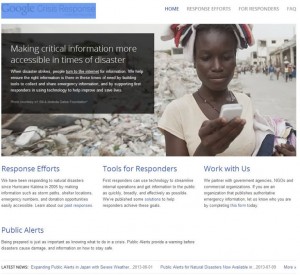Driving home the notion that most U.S. employees believe their employers aren’t prepared for a disaster or a major crisis may be one of the best way to get people to take notice that September is National Preparedness Month.
That was the tack taken on the last of three webinars presented by Agility Recovery Solutions and the United States Small Business Administration. Wednesday’s webinar was titled “Crisis Communications Planning.” It followed last week’s webinar, “The New 10 Steps to Preparedness,” and a webinar a week earlier, “Protect Your Organization by Preparing Your Employees.”
“Seventy-five percent of the employees in the United States do not think their employers have a plan and are prepared for disaster,” said Bob Boyd, president and CEO of Agility Recovery Solutions.
Boyd further drove home the need for companies, as well as their insurance agents, to be prepared for emergencies by having a detailed communications plan.
“I honestly think that this is one of the most important things an organization can tackle when they’re getting ready to plan for a disaster or event,” he said, adding that a good communications plan in the event of disasters or crisis situations can help firms speed up recovery.

Setting expectations is a first step Boyd advised taking, and it’s a step that helps leaders realize that “things don’t tend to work the way they worked before the disaster, before the event,” Boyd said.
A communications strategy that can be relied upon should be one in which managers and their employees have different place to get information, such as a news channel, a webpage or social media. Landlines, cellphones and email may not be an available communications tool due to power outages or provider issues, according to Boyd.
“In a disaster you need to assume all of those things you use regularly to communicate aren’t available,” Boyd said.
He suggested several steps to ensure redundancies in a communications plan.
- 24-hour phone tree
- Password protected webpage
- Previously established radio/TV/print news partners
- Call-in recording system
- Email alert system
“By having a really well thought-through communications strategy … I promise you you’re going to make any recovery much more efficient and effective,” he said.
The bottom line, Boyd added, is that “your people are going to know what you want them to do.”
Consider the Audience
Boyd suggested considering the different audiences a company must be able to communicate with during an emergency or a crisis: Employees; stakeholders; suppliers; clients; media; lenders; community; competitors; regulators.
“You have different consumers of information in a disaster, different stakeholders,” Boyd said.
Another outreach consideration should be online message boards. Using Google Groups as an example, Boyd noted the groups are password protected, a good way to provide information, they enable employees to provide their own status and location updates and they make for a good virtual meeting place.
Staying on the topic of Google, he noted that Google.org also has a crisis response project, Google Crisis Response, with several tools that can enhance communications and response efforts.
They tools offered by the Google service include:
- Google Public Alerts
- Google Person Finder
- Custom Google Maps
- Google Earth
- Google Docs and Spreadsheets
External Communications
Companies without an external communications strategy risk leaving customers, vendors, partners and others in the dark as to whether they are in a position to recover from an event.
“If you don’t have an external communications strategy, none of those people are going to know what you are doing about it,” Boyd said.
Maintaining or reestablishing a company’s online presence should be a top priority following a disaster or crisis, he said.
Steps suggested include:
- Ensuring managers can remotely access the company website, and having a backup web content manager
- Having the ability to immediately post critical information on the homepage
- Providing employees, clients, customers and business partners with timely information about the company during a crisis
- Ensuring the site can handle potential spikes in visitor traffic during emergencies
Running regular tests of emergency plans and lines of communications are an essential part of disaster planning, according to Boyd.
“I promise you, you want to have practiced this a lot of times before any crisis,” he said.
Media Communications Planning
Lastly, Boyd emphasized the need to be prepared to deal with the media in times of disaster or crisis.
“The media is your friend,” he said. “They are there to report the news.”
Be able to communicate to the media, and be able to do so succinctly and effectively, he advised.
To that end, Boyd suggested establishing a crisis communications team:
- Identify a spokesperson or spokespersons
- Train the spokespersons
- Establish a policy for employee interaction with media, on and offsite
- Ensure all employees know who the spokesperson is and how to reach them
“Never say, ‘No comment,’ ‘No comment,'” Boyd said, adding “that tells them there’s a problem here.”
This ended Agility’s series of National Preparedness webinars. However, there is a webinar on Oct. 23 titled “Winter Weather Preparedness,” which will include an expert from the National Oceanic and Atmospheric Administration.
Topics USA Commercial Lines Business Insurance Training Development Google
Was this article valuable?
Here are more articles you may enjoy.


 Florida Lawmakers Ready for Another Shot at Litigation Funding Limits
Florida Lawmakers Ready for Another Shot at Litigation Funding Limits  SIAA Announces Strategic Partnership With Progressive
SIAA Announces Strategic Partnership With Progressive  Wildfires, Storms Fuel 2025 Insured Losses of $108 Billion: Munich Re Report
Wildfires, Storms Fuel 2025 Insured Losses of $108 Billion: Munich Re Report  Consumer Acceptance of Telematics Widens, Says Survey
Consumer Acceptance of Telematics Widens, Says Survey 

